This post may contain affiliate links. See our disclosure policy.
If you’re looking to make your own Chinese food at home instead of spending money on takeout, then this copycat Panda Express Chow Mein recipe is perfect for you!
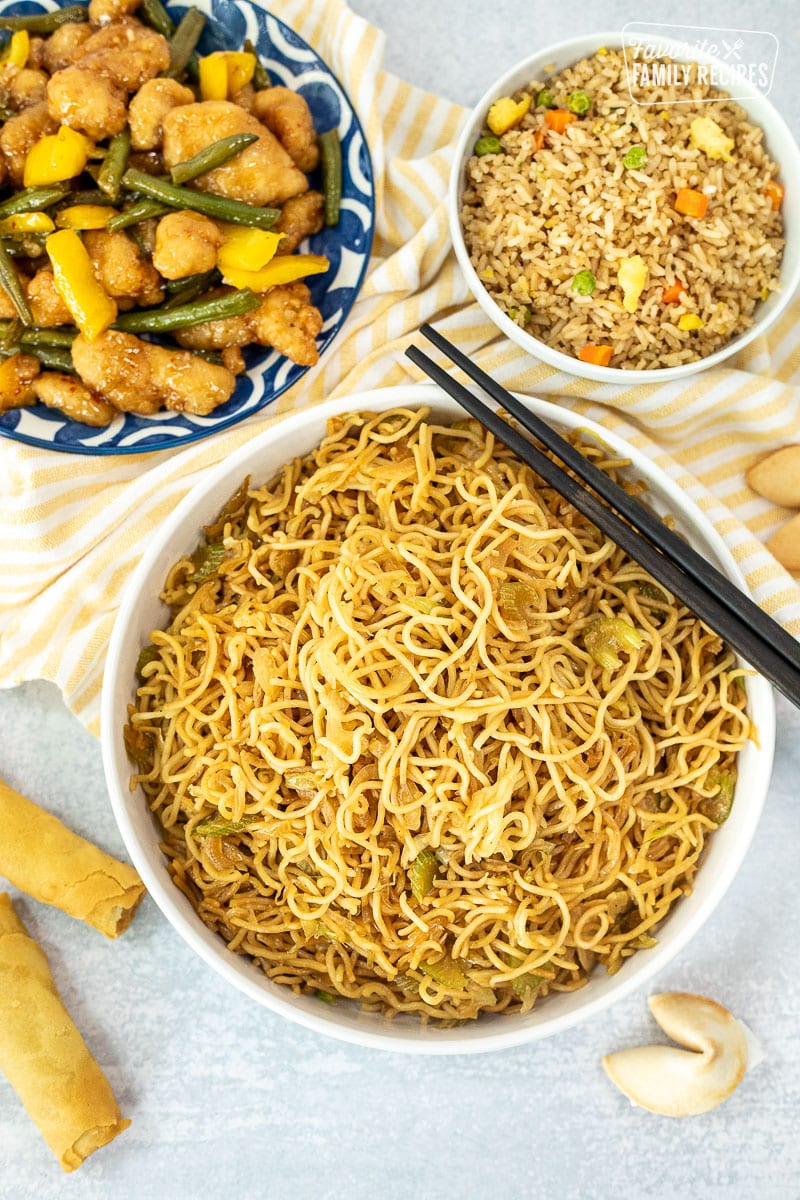
Panda Express Chow Mein is a side dish that you can get at Panda Express. It’s made with noodles and vegetables. This Chow Mein recipe is a very close replica of the restaurant’s signature side dish. Make a healthier version of this Chow Mein at home for a fraction of the price!
This easy Chow Mein recipe uses fresh, simple ingredients from right in your own pantry, and it can be on your table in less than 30 minutes! It’s one of those recipes that makes enough to feed the whole family, so if there are leftovers, you can store them in a sealed container. The noodles reheat beautifully and you can eat from this dish for up to a week!
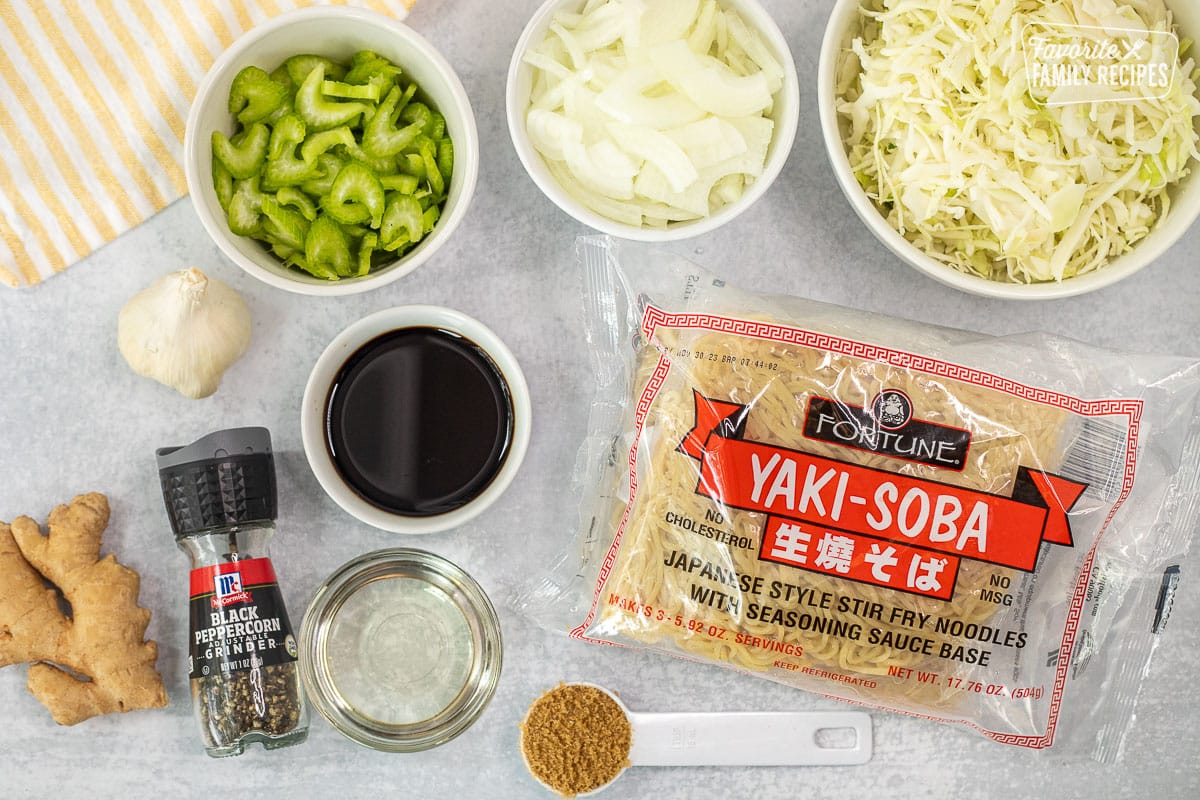
Panda Express Chow Mein Ingredients
The ingredients in Panda Express Chow Mein are simple. I love how Panda Express doesn’t complicate things. Of course, if you are making this on your own you can take your own creative liberties and add extras to your liking. Here’s the basic ingredients:
- Chow mein noodles: Prepared according to package instructions. Yakisoba noodles, lo mein noodles, or even ramen noodles can also be used. If using ramen, I have found they work out best if they are undercooked by a minute.
- Onion (white or yellow onion)
- Celery
- Cabbage
- Chow Mein Sauce
Chow Mein Sauce:
For this chow mein sauce we only use a few simple ingredients:
- soy sauce
- brown sugar
- garlic
- ginger
- black pepper
You can also add a little oyster sauce or a splash of cooking Chinese cooking wine to the sauce for more depth of flavor. If you want to make more of a saucy sauce (not like Panda Express and more of a lo-mein style), you can double the sauce recipe, and add a cup of chicken broth. Heat the sauce on the stovetop until sugar is dissolved and slowly add a slurry of cornstarch and water until the sauce slightly thickens JUST enough to lightly coat a spoon. Then add the sauce to the noodles to taste (you may not want to use all of it).
If you want to get creative, you can add:
- Chicken, beef, or shrimp
- Carrots
- Red bell pepper
- Snow peas
- Shitake mushrooms
- Bean sprouts
- Green onion
- Egg
- Tofu
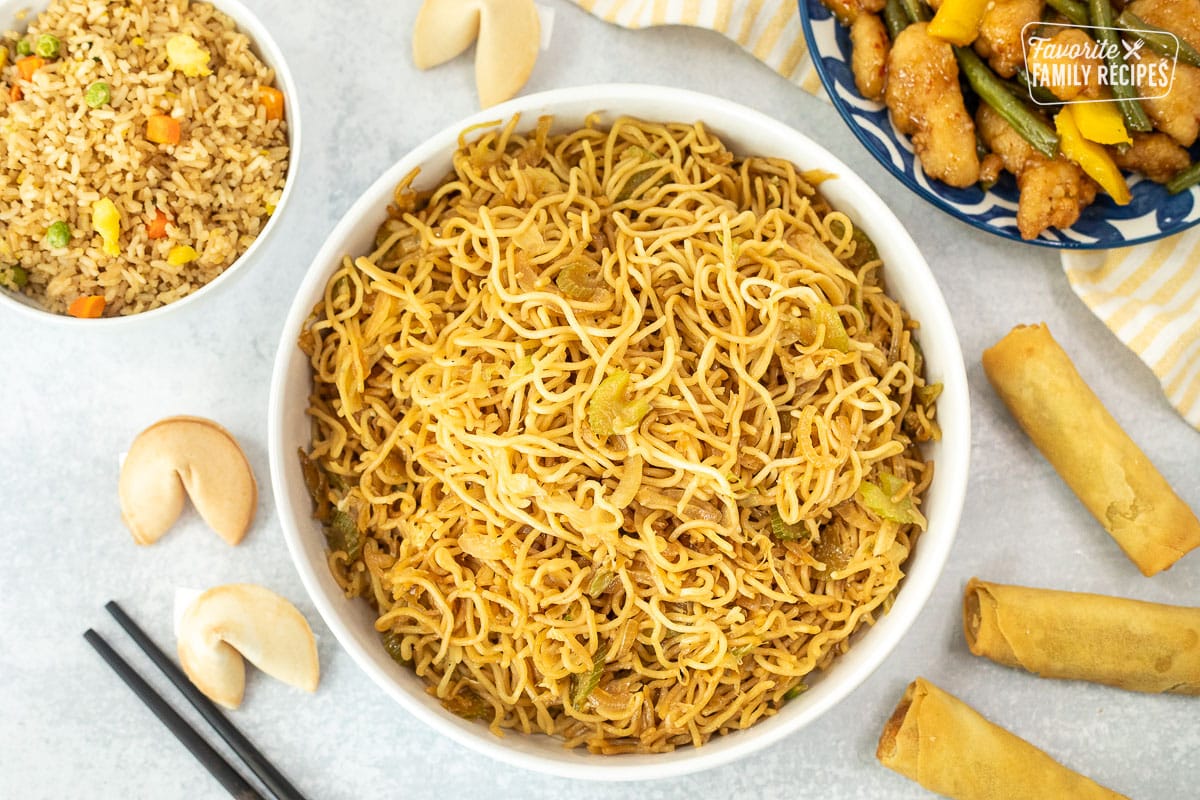
Chow Mein vs Lo Mein
Sometimes, it is difficult to tell the difference between chow mein and lo mein, but after I go through the three main differences, you will easily know which is which. The biggest difference is simply knowing that one is stir-fried and the other is tossed in sauce.
Chow Mein:
- Translation: Translated, “chow mein” means “fried” or “stir-fried” noodles.
- Preparation: Chow mein noodles are parboiled and then stir-fried in a wok with vegetables and other ingredients until the noodles cooked through
- Texture: Because chow mein noodles are stir-fried, the noodles become slightly crispy and a bit oily. The fried texture makes it so it can’t really be “slurped”. Some think that chow mein noodles are strictly crunchy, deep fried noodles, like the kind that comes in a canister, but that is only one type of chow mein noodle. The most common kind of chow mein noodle is the stir-fried kind, like they use at Panda Express.
- Sauce: There is very little, if any, sauce with chow mein noodles.
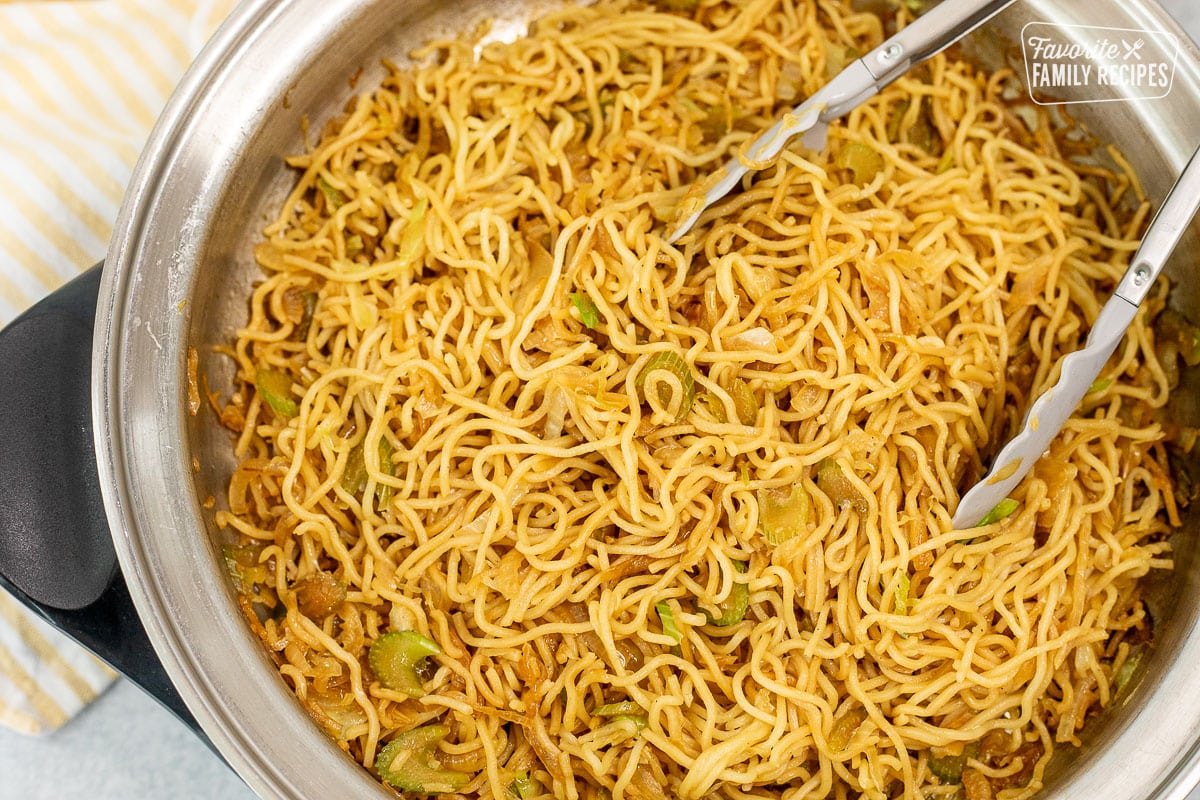
Lo Mein:
- Translation: Translated, “lo mein” means “tossed” noodles.
- Preparation: Lo mein noodles are parboiled until soft and then tossed with sauce and other ingredients.
- Texture: The texture is more soft in a lo mein noodle. It feels similar in texture to a spaghetti noodle. A lo mein noodle is easy to slurp.
- Sauce: Lo mein is tossed in a good amount of sauce.
Some may argue that Panda Express chow mein is a LO mein, but looking over these qualifications above, you know that is actually IS a chow mein. Panda got it right. The noodles are stir-fried, they are a little oily, there is little sauce used, and they aren’t easy to slurp. In my opinion, it all comes down to that “slurp” test! Now, can you make this recipe a lo mein if you wanted to? Absolutely! It is DELICIOUS as a lo mein! Just boil up your noodles separately and double the sauce. Toss together and serve.
What Kind Of Noodles Are Best?
You can use various types of noodles for chow mein, and as long as you stir fry them in some oil, you’re good to go! We prefer Yakisoba because it consistently provides the right texture, but you can also cook dry lo mein noodles, drain them well, and then stir fry them in oil. Ramen noodles are another option. Whichever type you choose, remember to discard any included flavor packets. If you don’t have any of these noodles available, you can still use simple spaghetti or linguini noodles by stir-frying them.
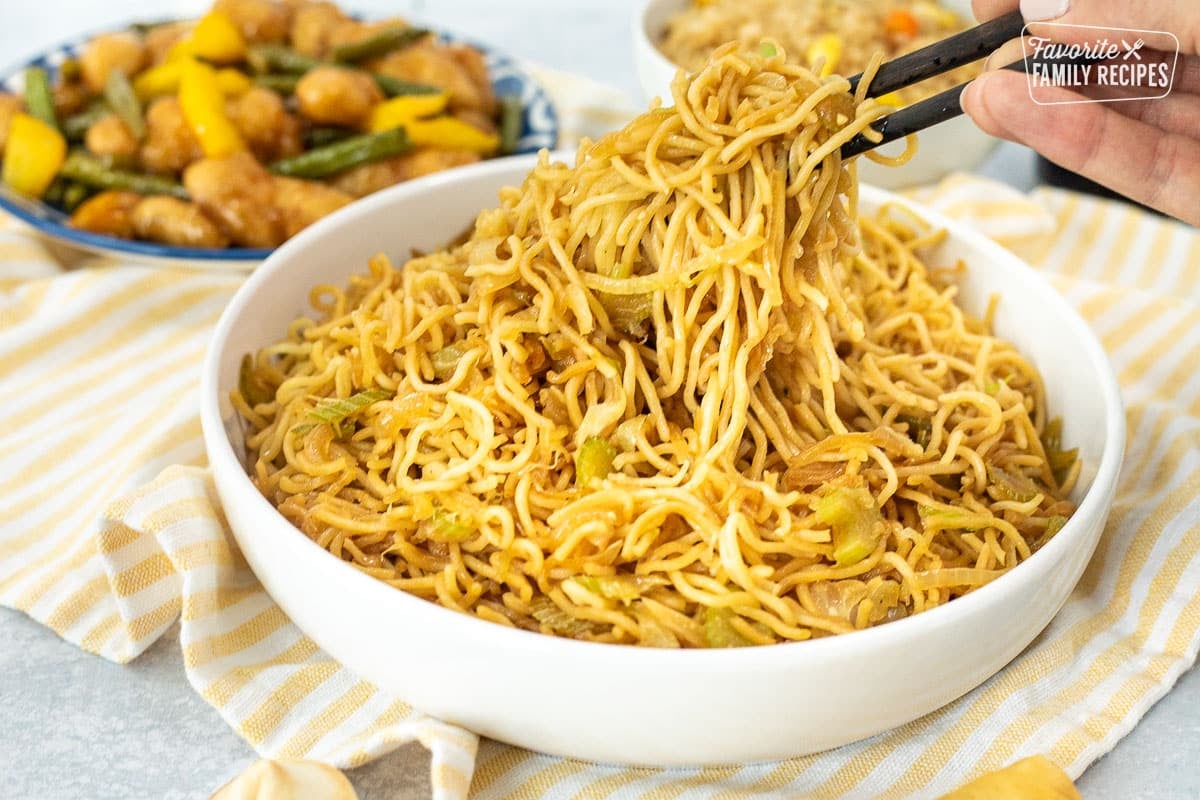
Suggestions for this Recipe
- This simple recipe makes several good sized servings, so if you find yourself with leftovers, store it in a sealed container in the fridge. The noodles reheat beautifully and you can eat from this dish for up to a week!
- Use a large wok, skillet, or deep-walled non-stick pan to make stir-frying easier.
- In this recipe, you can add a shake or two of sesame oil to the vegetable oil to add a deeper flavor, but make sure to use it sparingly. The sesame oil flavoring can overpower the rest of the flavors. I have made it both ways (with and without sesame oil) and they both taste great.
- This recipe calls for celery, onion, and cabbage but you could add shredded carrots, pea pods, broccoli, or any of your favorite veggies to this dish.
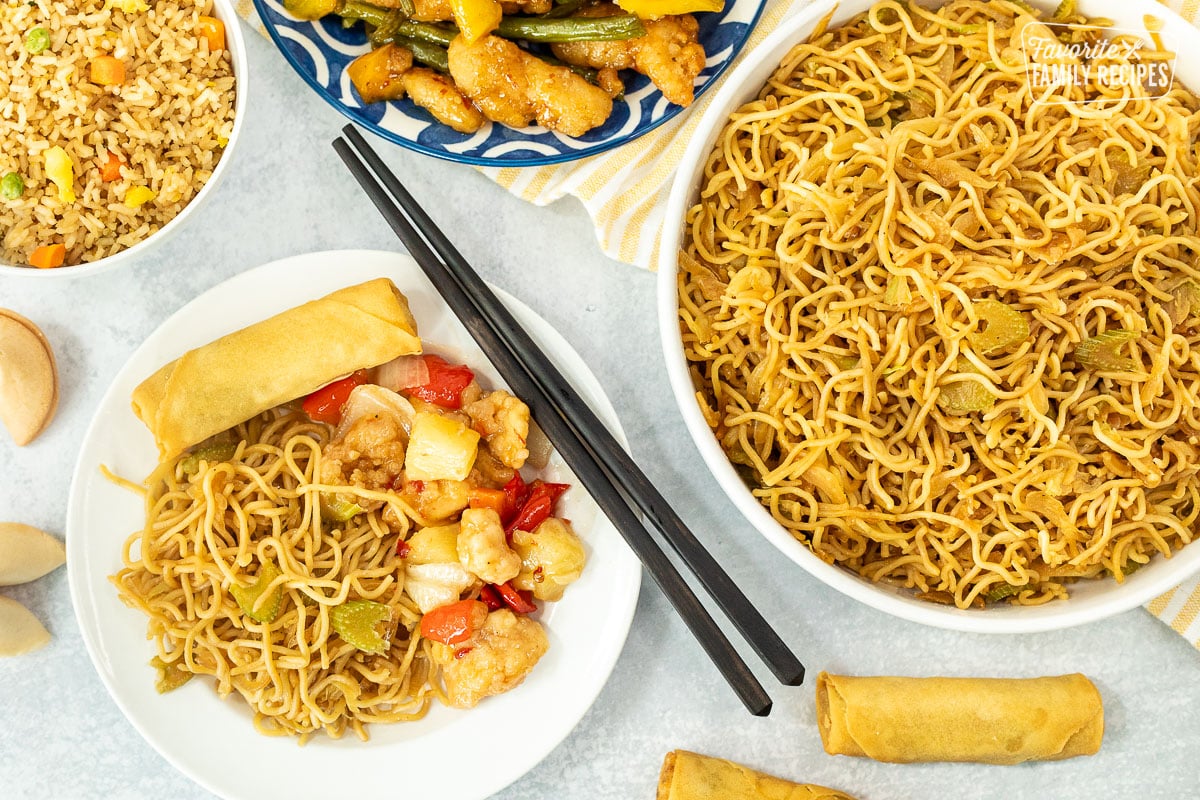
Storing and Reheating Chow Mein
To store leftover chow mein, cool it down to room temperature and place it in an airtight container. Refrigerate for up to 4-5 days. To reheat, use the microwave for quick warming, the stovetop for better control, or the oven for larger portions. For microwave and stovetop, add a touch of oil, if needed, and heat until it’s heated through. In the oven, cover with foil and bake at 350°F for 20-30 minutes. Keep an eye on it to prevent overcooking. You may need to add a bit of water or sauce to maintain moisture. Enjoy your reheated chow mein!
More Panda Express Recipes
Pair this Chow Mein with some of our other Asian-inspired recipes like Kung Pao Chicken, Chinese Barbeque Pork or any of these other Panda Express recipes:
Frequently Asked Questions About Chow Mein
Chow mein is a noodle made from wheat flour and egg.
In this recipe, we use soy sauce, brown sugar, ginger, and garlic to make chow mein sauce.
Lo mein is healthier simply because the noodles used in lo mein aren’t fried.
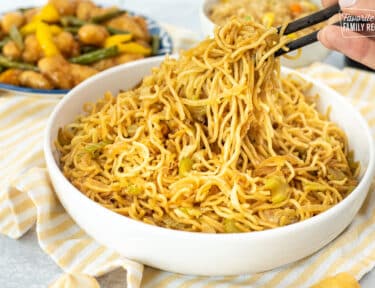
Panda Express Chow Mein (Copycat)
Video
Ingredients
- ¼ cup soy sauce
- 1 tablespoon brown sugar
- 2 cloves garlic, minced
- 1 teaspoon grated fresh ginger
- ground black pepper, to taste
- 2-3 tablespoons vegetable oil
- 3 (5.6 ounce) packages Yakisoba noodles or Chinese Egg Noodles (Found in the produce section of the grocery store. Usually, the 3 packages are sold together in one 17oz. pack)
- ⅔ cup diagonally chopped celery chopped diagonally
- 1 medium onion, thinly sliced
- 2 cups chopped cabbage
Instructions
- In a small bowl, combine soy sauce, brown sugar, garlic, ginger, and black pepper. Set aside.
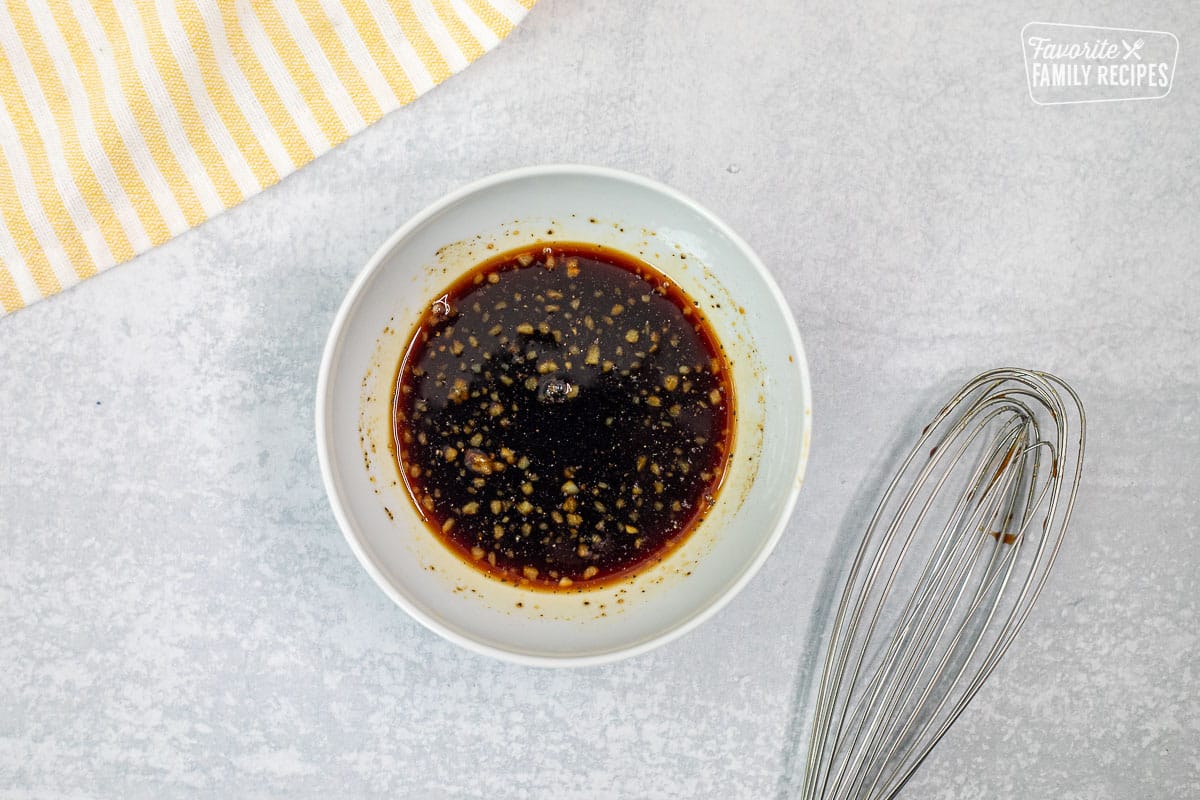
- Remove noodles from packages and discard included flavoring packets. Rinse noodles well, drain, and set aside.
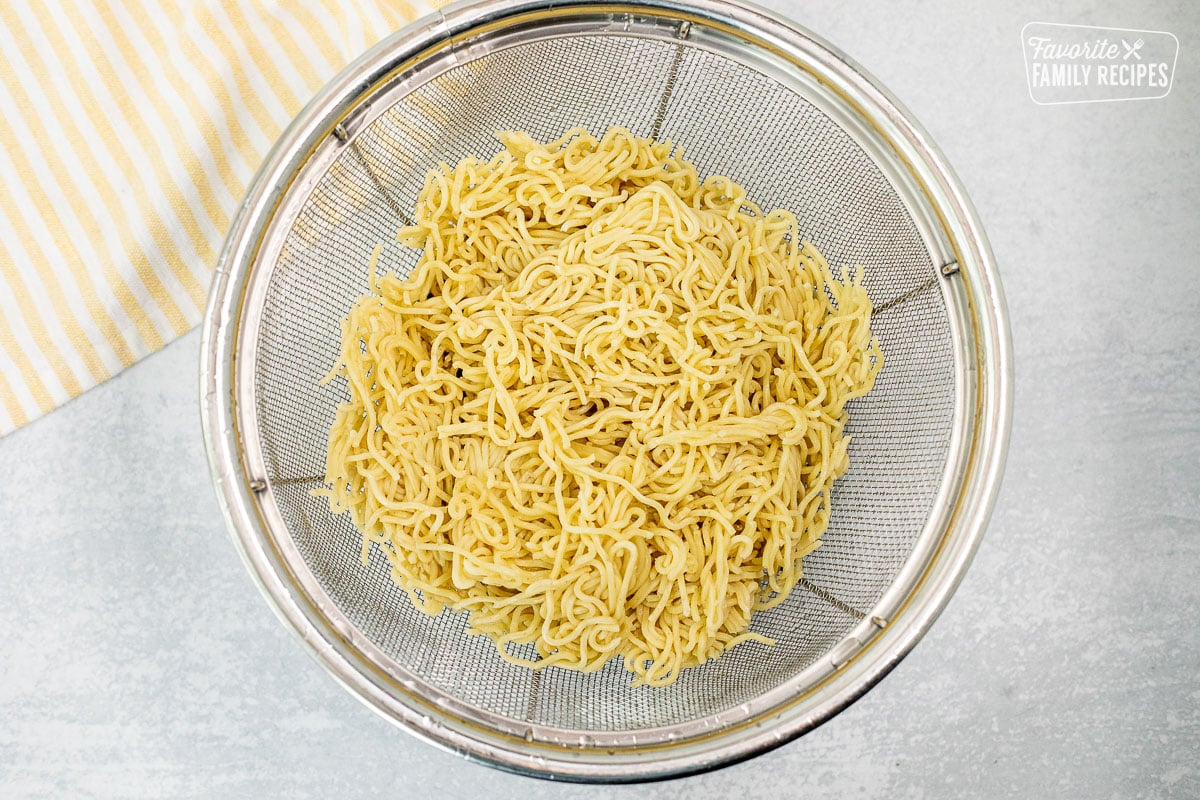
- Heat oil in a large wok or skillet over medium heat. Add celery and onion and sauté for about 1-2 minutes or until onions start to become soft and transparent. Add cabbage and sauté an additional minute.
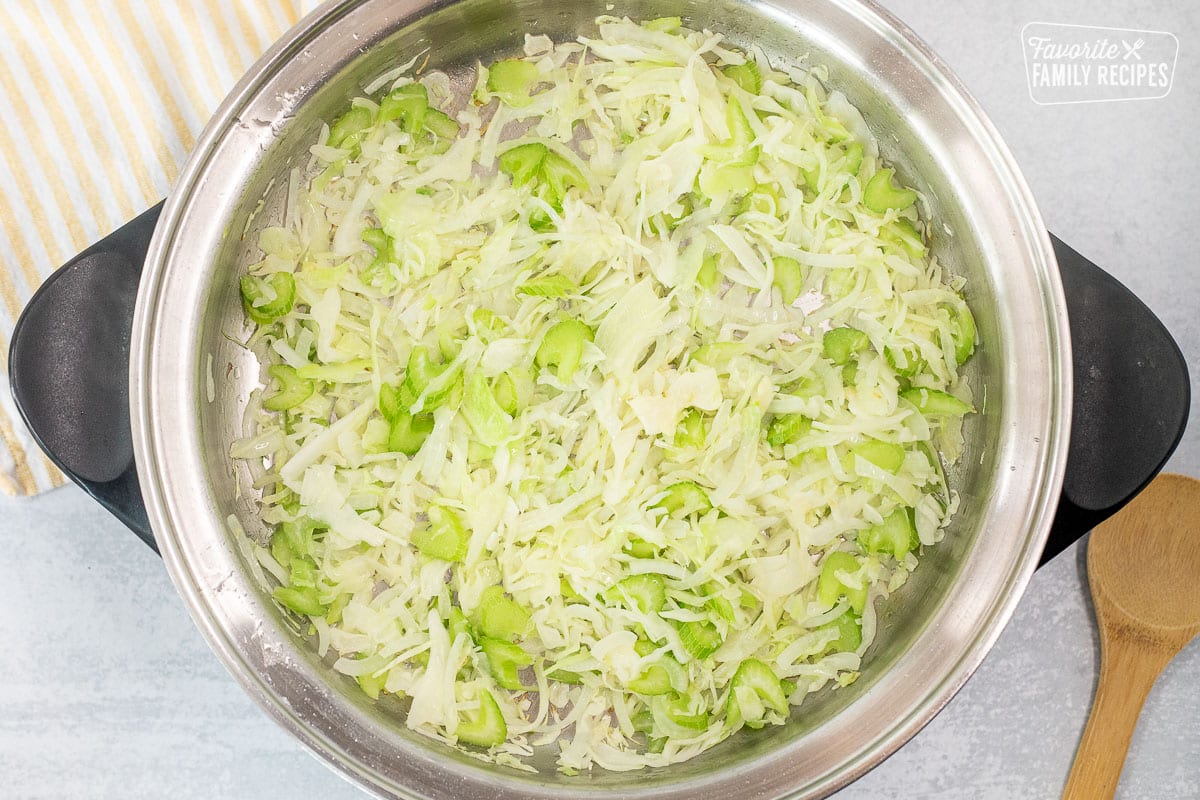
- Add noodles and soy sauce mixture to the vegetables. Stir-fry over medium-high heat for an additional 2-3 minutes or until noodles are heated through.

Notes
- In this recipe, you can add a shake or two of sesame oil to the vegetable oil to add a deeper flavor, but don’t overdo it! I am not including it in the recipe because the sesame oil flavoring can become overpowering really quickly if you aren’t careful. I have made it both ways (with and without sesame oil) and they both taste great.
- Feel free to add more vegetables or a variety of vegetables to your chow mein. Just because Panda Express only uses onions and celery doesn’t mean you have to limit yourself!
- Yakisoba noodles can be found in the produce section of the grocery store. Usually, the three packages are sold together in a single 17-ounce pack.
- Don’t overcook the noodles. Overcooking them can cause them to break. You want them to be just heated through.
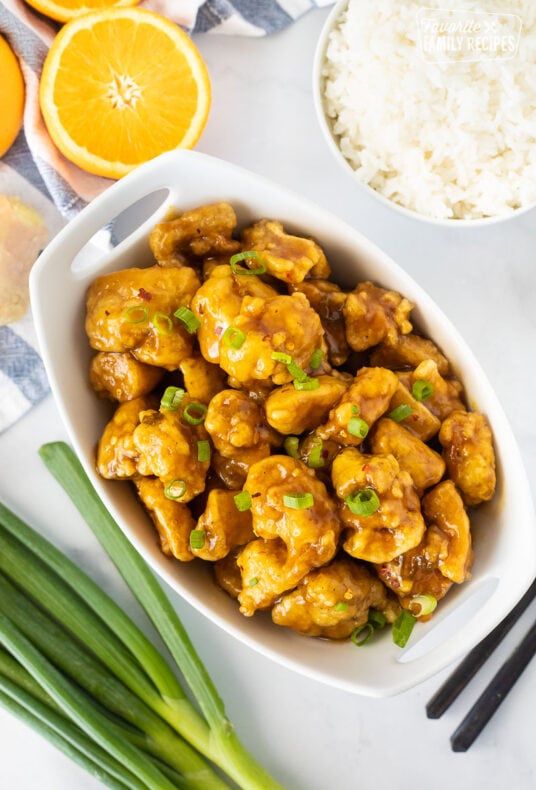
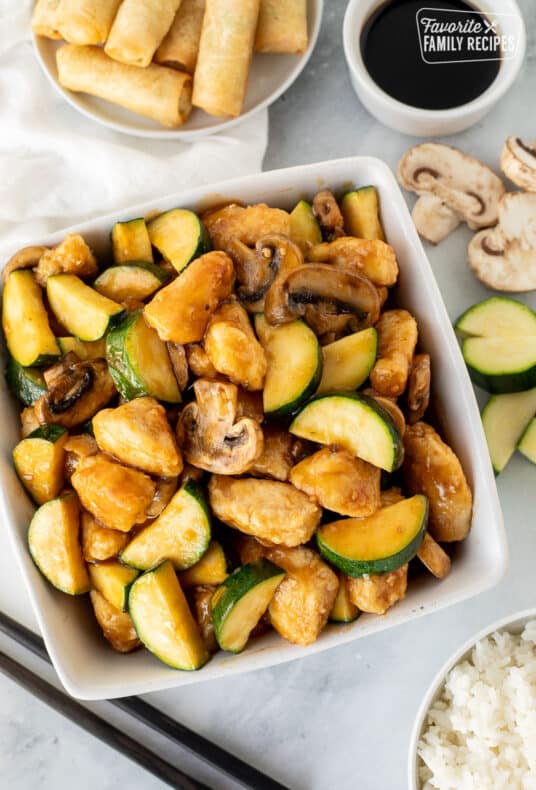
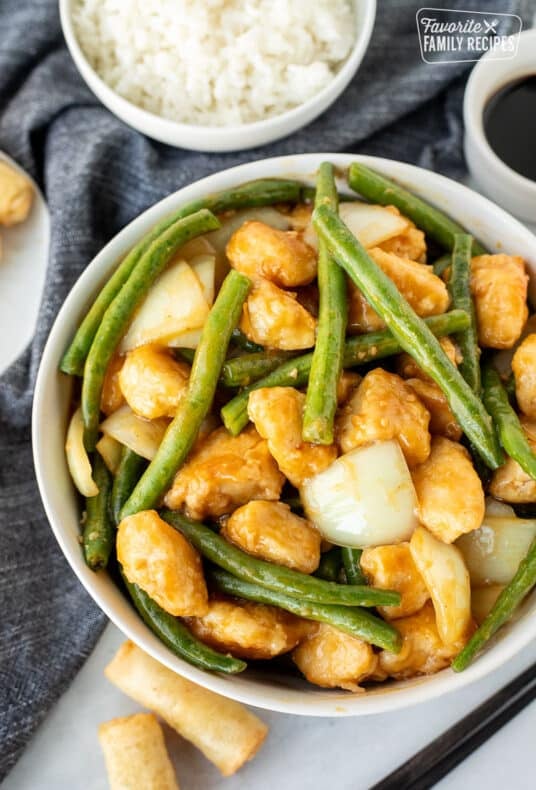
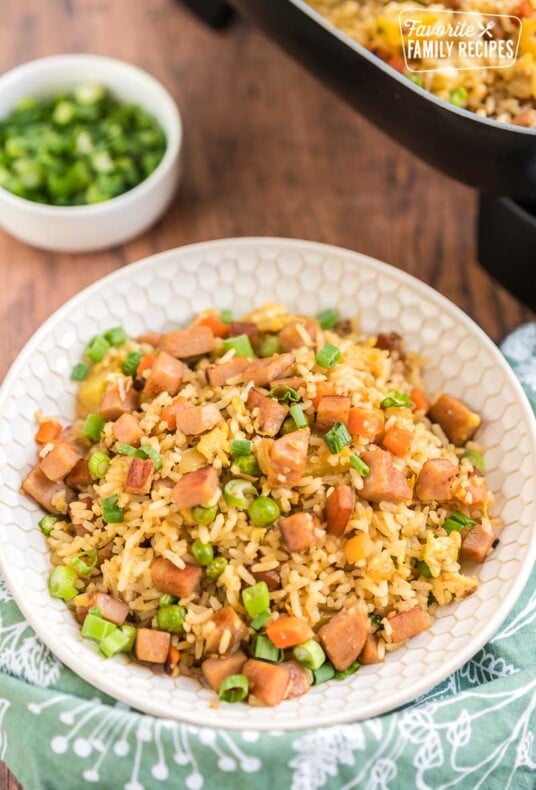
OOoops. *I meant don’t discard the noodle seasonings packages..
Great. I use this recipe all the time.
But don’t discard the noodle packages. You can use them sparingly to sprinkle on anything in other recipes!
I also add chicken and other veggies, from time to time, like peas and carrots,
But your ingredients are spot on. Thanks.
I did this recipe with ramen noodles turned out amazing super easy!
Loved this recipe. Sadly I forgot to rinse my noodles which led to them clumping – so everyone, DO NOT FORGET TO RINSE THEM. Otherwise would have been great.
Love it
So every Chinese menu is backwards? Lo mein has noodles. Chow mein does not. This recipe does sound good and fairly simple to make Lo mein at home.
Panda Express calls their noodles Chow Mein, Lo Mein does not appear on their menu.
I lived in Japan a total of 7 years. I ate at many Japanese and Chinese Restaurants. Growing up in the U.S. I always ordered Chow Mein. When I asked for it there, I was told they didn’t have any because it was an American Dish! I made recipes for all the foods I loved there. I’m still adding this Chow Mein recipe to my “Oriental Recipes”. Thank you for a great recipe 🙂